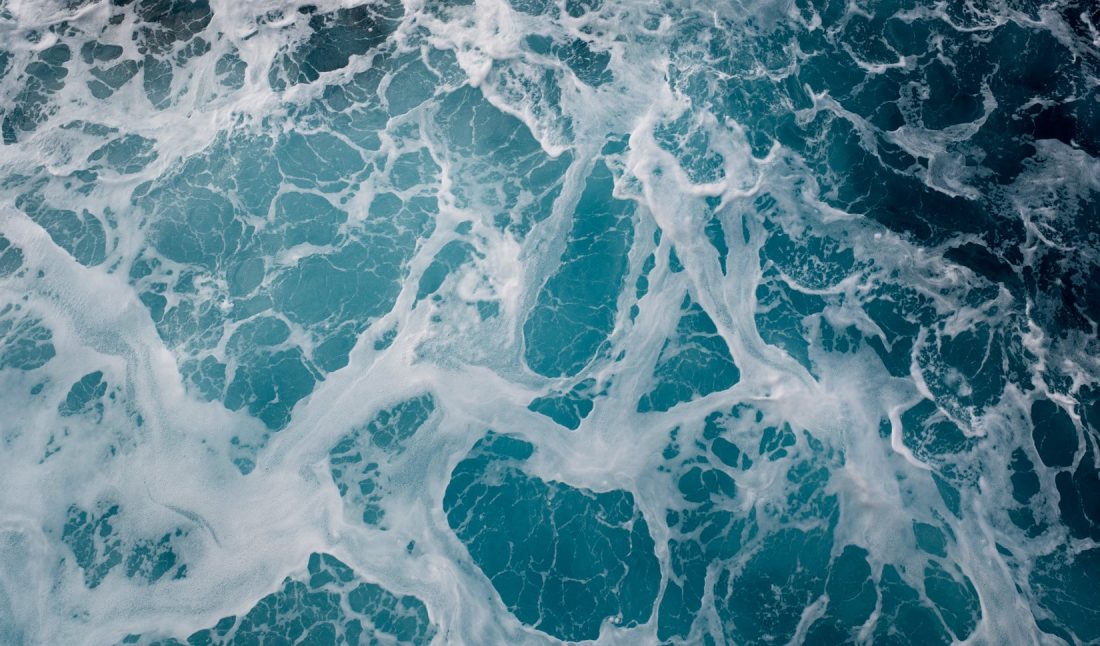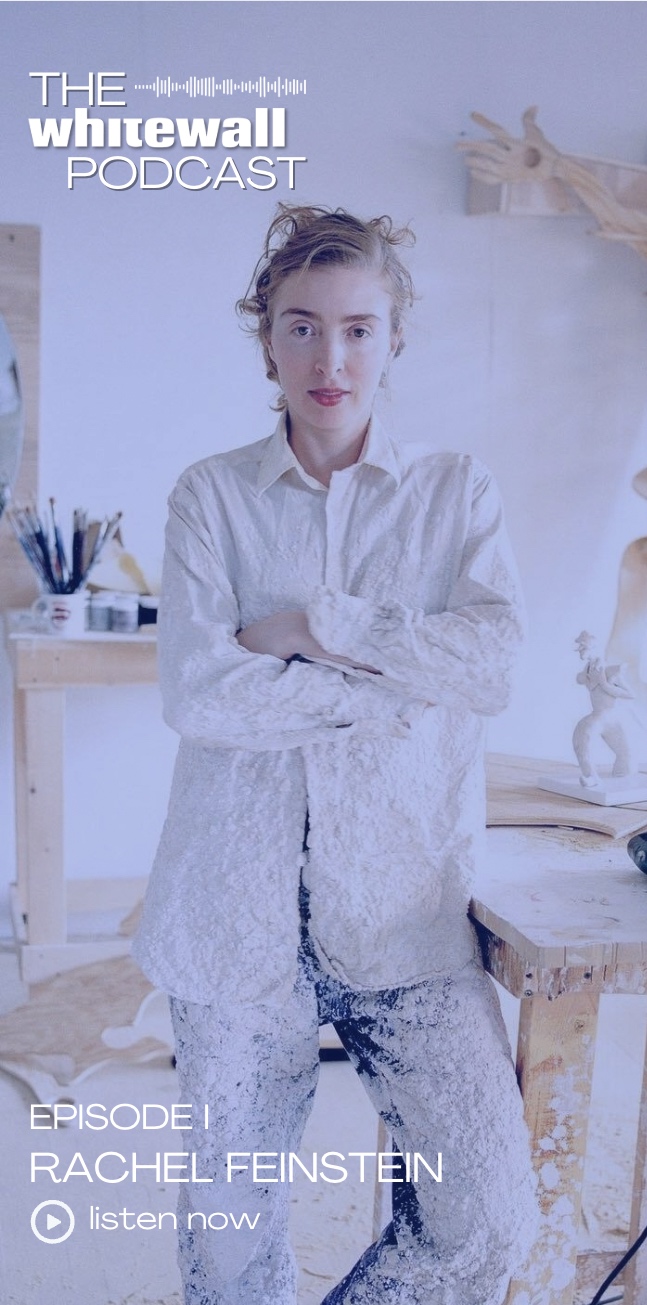Cole Sternberg’s “thirsty while drowning” is currently on view through January 18, 2023 at the University Art Collection and Gallery at Villanova University. The campus-wide exhibition by the artist and Villanova alum transforms the campus and gallery with thought-provoking works that, while entrancingly beautiful, scream out the impending consequences that we face at the hand of climate change.
“There’s something special about the Villanova alumni network it really is a continuation of the community that I feel a part of every day. So to have such a renowned artist return to campus was a no-brainer,” said Jennie Castillo, the Curator of the University Art Collection and Gallery Director at Villanova University.
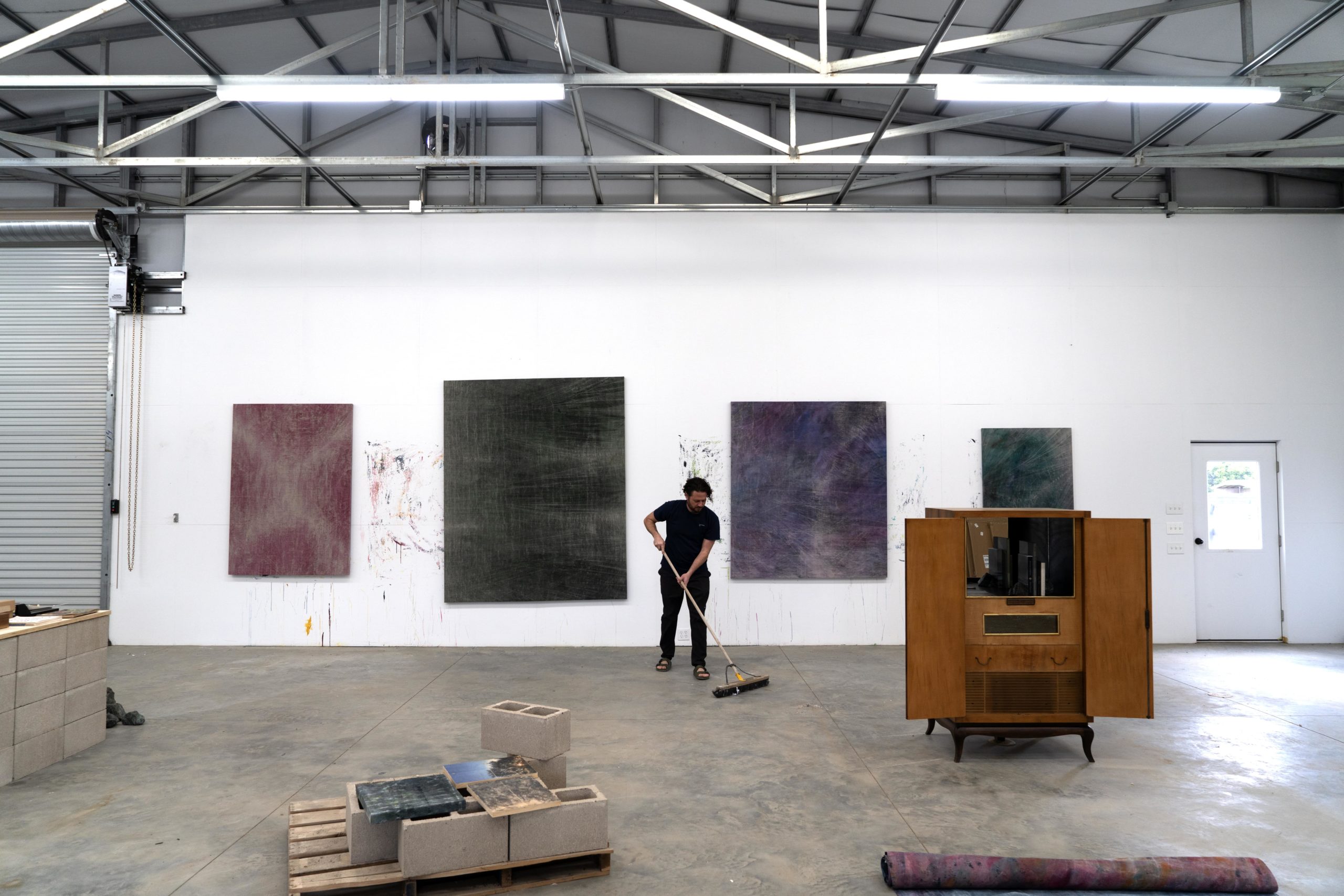 Cole Sternberg in his studio, courtesy of the artist.
Cole Sternberg in his studio, courtesy of the artist.
Sternberg’s objective with the exhibition was to activate the minds of the student body, engaging with them in far more intriguing ways than just canvases on the walls of a gallery. “My first in-person meeting with Cole lasted about seven hours,” Castillo noted. “We walked around campus with curiosity and chatter and brainstorming and a ton of ‘what ifs.’ Although our art gallery is in the Connelly [Building] (our student union building) not many students knew it even existed, this became our follow the ‘Easter eggs’ that lead to the pièce de résistance.”
Flooding far beyond the Connelly Building, the final form of “thirsty while drowning” sees multiple structures around campus—the Vasey black box theater, the Jake Nevin Fieldhouse, and the Business School’s Bartley Hall—bearing evidence of Sternberg’s environmental musings, painted both indoors and out with photographic murals taken from imagery of his journey across the Pacific Ocean on a shipping vessel. After following the evidence around campus, it is the hope of Sternberg and Castillo that students will make their way to the Art Gallery, where the artist’s signature works—painted canvases completed in collaboration with nature—continue the oceanic themes that ripple across the campus. To learn more about the encompassing project at Villanova University and Sternberg’s intriguing earth-informed practice, Whitewall spoke with the artist to learn more.
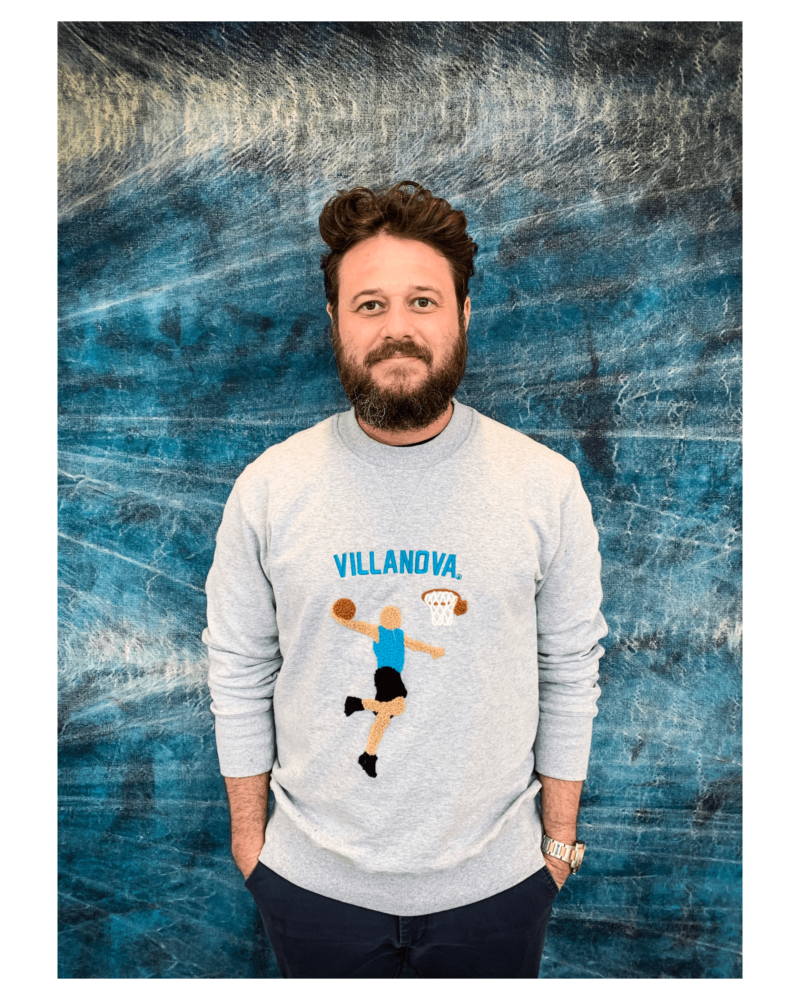 Portrait of Cole Sternberg courtesy of Villanova University.
Portrait of Cole Sternberg courtesy of Villanova University.
WHITEWALL: When you were invited to do this exhibition, why was it important for you to extend it beyond the gallery walls?
COLE STERNBERG: When I went to Villanova I didn’t know there was an art gallery. Integrating the student body into the discussion was critical for me. We went and walked around campus and I noticed the black box theater, diagonal from the gallery. I thought, if I walked by that and saw a mural as a student, maybe I’d start thinking about the artwork a little bit.
Then, we went to the business school which had been completely redone. It was visually difficult for me—there were all these screens and information at the front, and a ticker tape. I mean, I went to the business school and I studied marketing. I thought, there’s a way I can address this situation, too.
The important thing is getting to the paintings in the end, with all of these markers along the way. There’s no way that a student can avoid seeing at least one of the murals. And because they’re on these different buildings for different majors, they’ll at least think about why these visuals are there and maybe get to the point of going to the museum and learning a little more about it.
WW: How did you arrive at the theme and the works on view?
CS: I have this imagery of crossing the Pacific. I thought I could make it look like one of the buildings is flooding. And from that idea, I decided I was going to focus on climate change and the environment, beautifully taking itself back and owning itself irrespective of what humankind does.
From there, my idea was to do a sort of mini-retrospective of my works that have been dragged in large bodies of water. I’ve been doing that for about six years and I wanted to touch on a few generations of those.
Then, it was shaping how I want it to feel in the space. One is size, and then the color palette. I wanted to have most of it feel like freezing or drowning and water in its hard state or liquid state, but also have a few that touched on land and fire and the other elements of the earth. It progresses through the space in that way. There are some that are a little more dark and foreboding and some that are a little more hopeful.
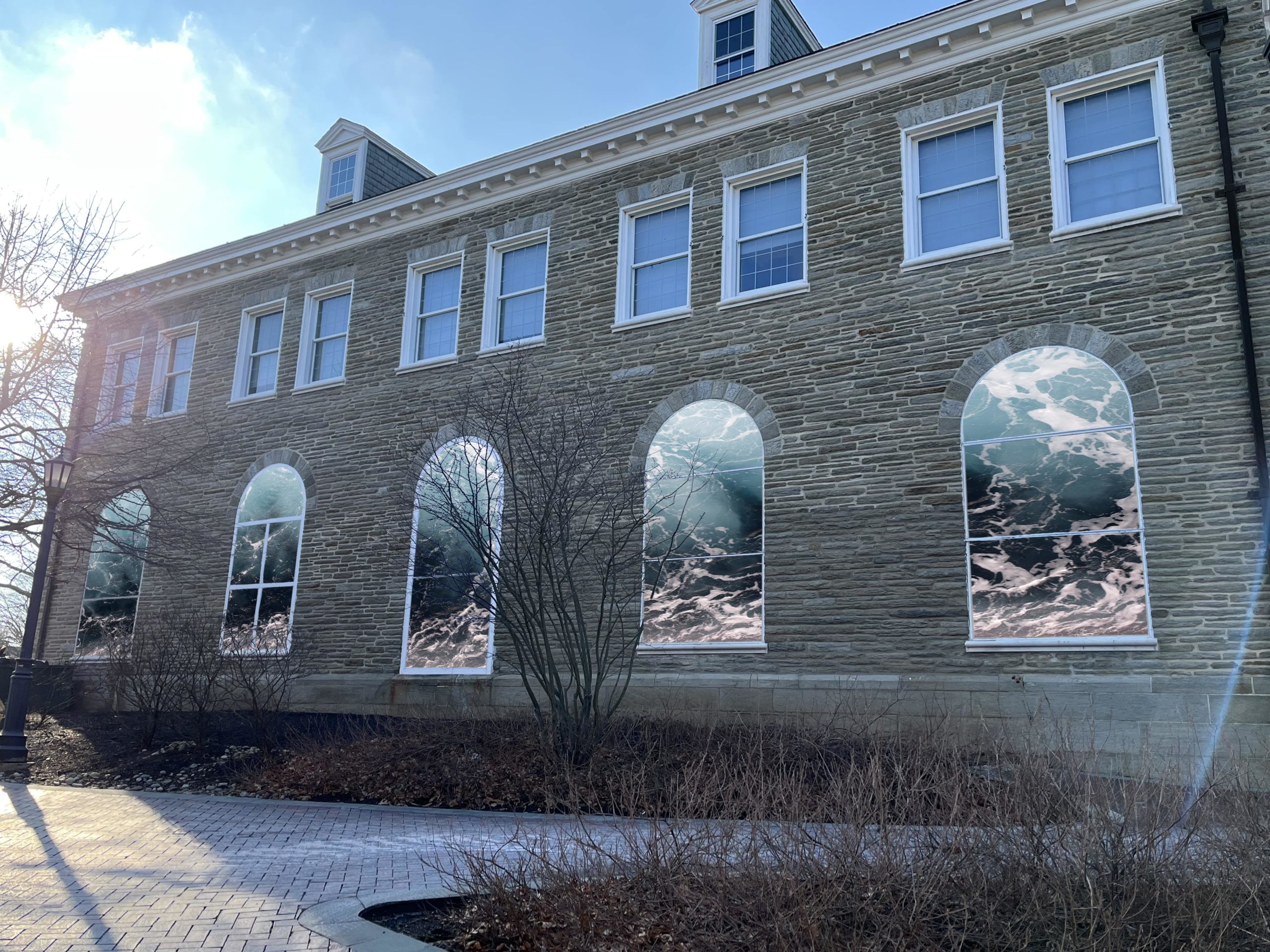 Cole Sternberg, “thirsty while drowning,” rendering, courtesy of the artist and Villanova University.
Cole Sternberg, “thirsty while drowning,” rendering, courtesy of the artist and Villanova University.
WW: How did your series of dragging paintings in bodies of water come about?
CS: I had this fascination—since college—about traveling across the Pacific because it was the longest distance you could travel. You don’t have cell coverage, you don’t see land, and you don’t see another ship for quite some time. I also, in parallel, got interested in trade and naval power and how the whole earth interacts. For example, an iPhone is designed in California, it was built in China, it comes on the ship here, we use it, and we used to send it back to China to be recycled… I just thought that whole movement across the world is so strange.
I thought maybe I could go on a shipping vessel across the Pacific, not a sailboat or private yacht. Finally, I found a way to get on a ship and I brought a documentary crew to capture the journey. I didn’t think it would be about me, more about the floating island, the people working on the ship, their lives, and how this little environment exists—because they stay together on the ship without much outside contact for six months at a time.
WW: How long were you on it?
CS: It ended up being 22 days. I set up the studio and painted as I would normally. I painted some on the big holds outside, as well, and hooked them with little carabiners and rope and tape. And then a heavy storm hit and we were locked in the interior for three days and I thought I had lost these three big paintings. But I went out and they had all ripped completely off their rope but they’d all saved themselves. They’d all wrapped around different bits of the ship like a human would hold [on]. That was the first inspirational thing.
Then, one day I got brave enough, when the captain wasn’t looking, to throw one in the water and that one came out as a rich blue watercolor palette and looked like light fracturing through the water. The human hand—my paintbrush strokes—had basically disappeared. That felt like a miracle—like the earth was composing it. You could call it a form of abstraction because I lose control, but it felt more like a collaboration with the earth.
And then over the years, I’ve been working on that method. What if I added a little acrylic to the mix or paint the back in a different way? Or go in freshwater or go at a different speed? I kept seeing different patterns, so it’ll be the light fracturing through, or the bark of a tree, or a sort of reptile skin. All these patterns repeating themselves were doing the same things on the paintings. That felt really special and I liked that idea because it’s like the earth is taking itself back—you don’t need me, these things could theoretically make themselves.
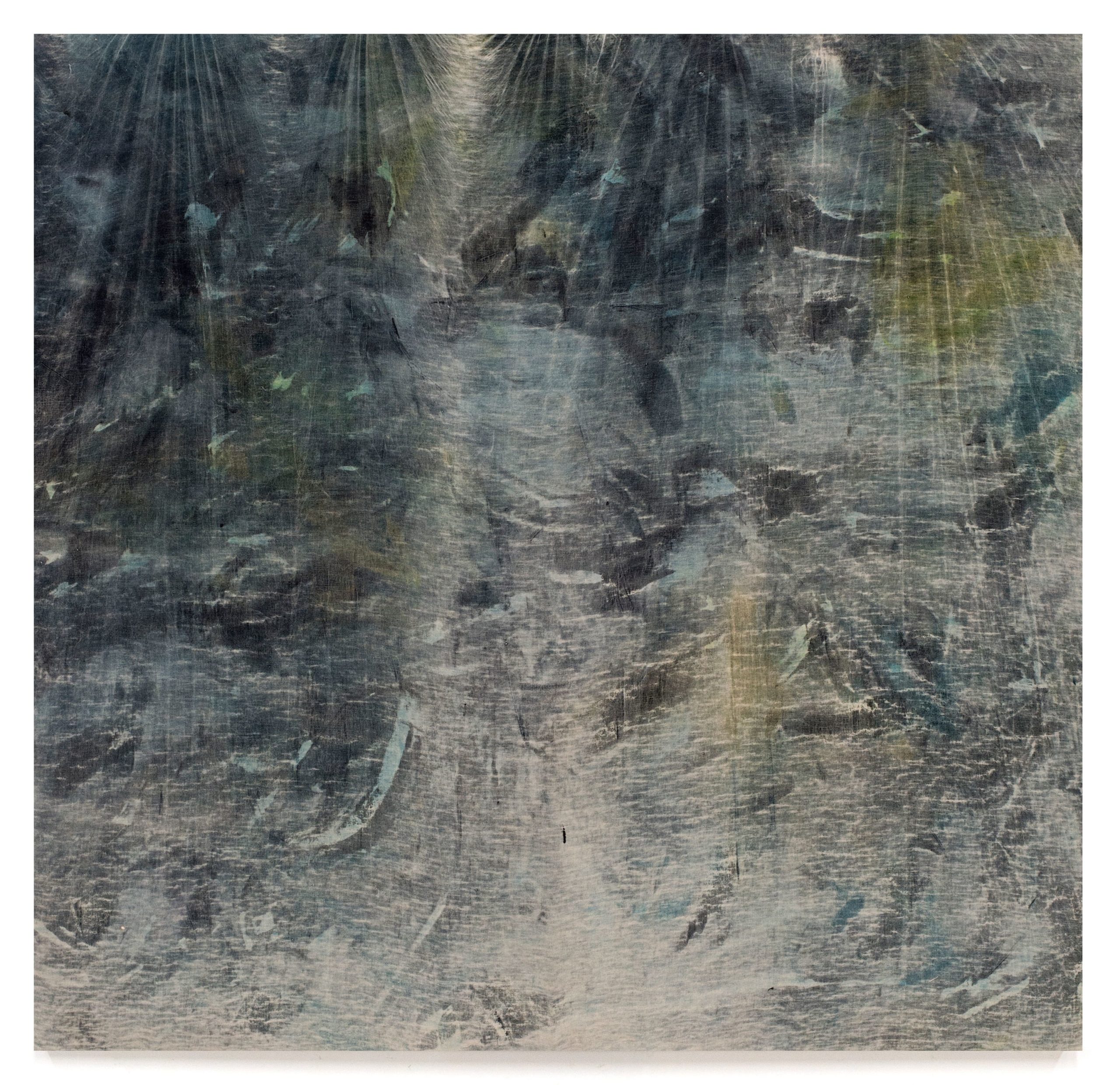 Cole Sternberg, “the foliage would brush their rigging at times,” 2018, Mixed media on linen, 76 x 78 inches; courtesy of the artist.
Cole Sternberg, “the foliage would brush their rigging at times,” 2018, Mixed media on linen, 76 x 78 inches; courtesy of the artist.
WW: Tell us about the murals across the Villanova campus—where are they located?
CS: We covered the theater and then in the business school there are two sets of them. One, you walk into the lobby [and] there are two large pillars that frame the doorway and go up three stories. It’s water going up both of those. I put a word only on two of the works and [on] that one, it says “ticker.” It’s up to interpretation, but it could be the stock ticker that it’s facing. It could be the clock ticking down to human mass extinction, it could be a heartbeat. That one is a direct play on what is happening in the space.
Then the other mural [has] two scenes of the water. There are big windows that are the same size—it’s like window, mural, window, mural, window. The windows look out on greenery and a sort of rich environmental space. How the green and blue, palette-wise play together, but also look how rich the environment is, whether you’re staring down at the ocean or through the window at this nice tree on campus—that one did probably the nicest job of interacting with an actual environment.
Then, the biggest one is the one on the old basketball stadium, which faces Lancaster Avenue, the main entrance of Villanova is right there. So it gets more eyeballs. For that one, I wanted to do something more dramatic and it’s as if the earth’s axis is tilted and the horizon is tilted and it’s a glorious sunset in the middle of the Pacific.
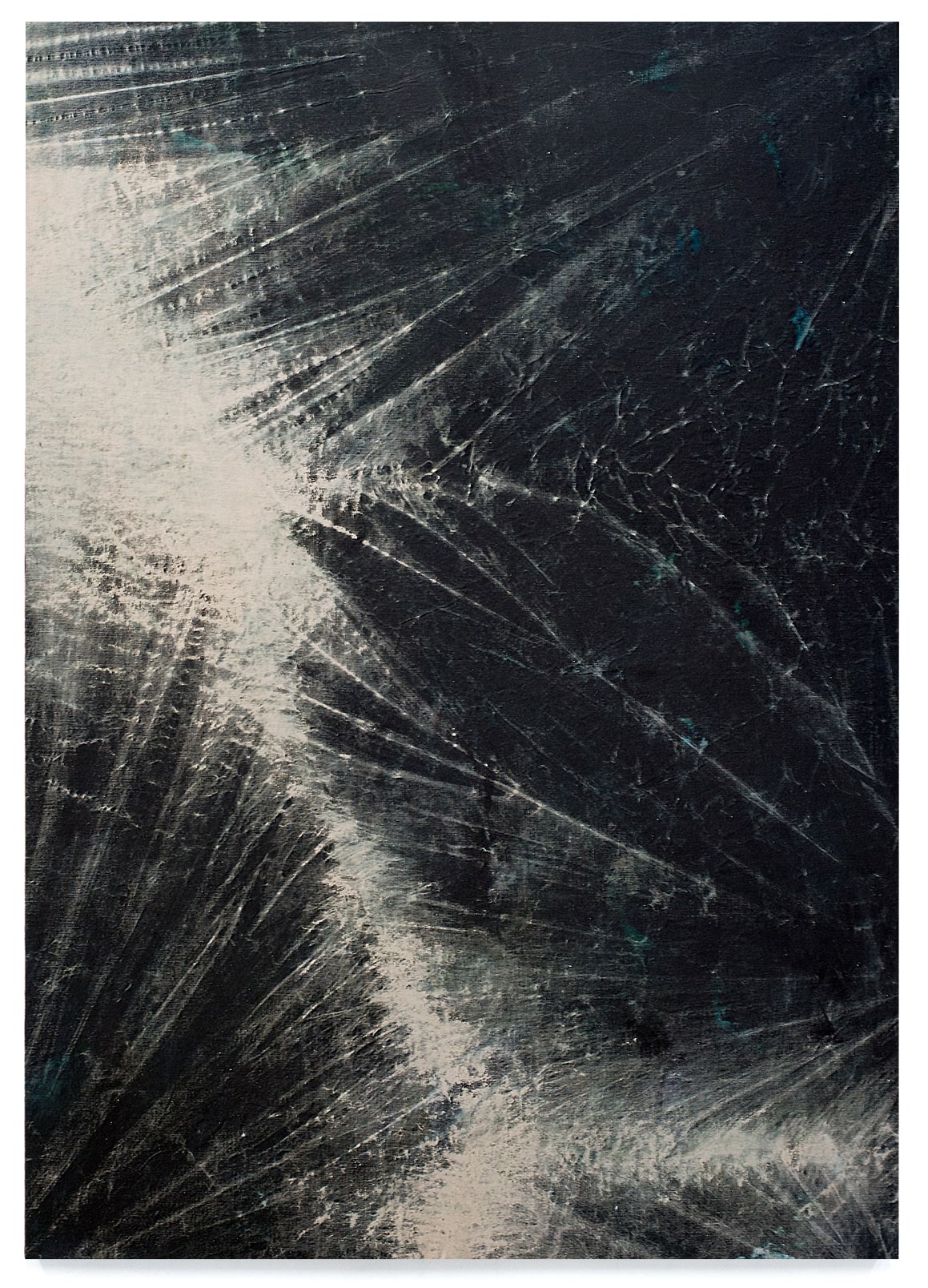 Cole Sternberg, “pattern research,” 2017, Mixed media on linen,
70 x 50 inches; courtesy of the artist.
Cole Sternberg, “pattern research,” 2017, Mixed media on linen,
70 x 50 inches; courtesy of the artist.
WW: In order for people to react and think about the message at hand, you do need to be a bit jarred. There’s obvious beauty there but there should be a little trepidation, fear, and urgency.
CS: Oh yeah, totally. That’s why the title is “thirsty while drowning”. It’s kind of a funny play on words, too, but it’s meant to be more shocking. The idea of drowning and being thirsty is a scary one but that’s what we are. We’re just consuming and consuming and burying ourselves.
WW: You did a tour of the show with students on campus. What was that like, especially as an alum?
CS: They were really into it. They seem a lot smarter than I was at their age. Their base of knowledge is pretty wide and they get it immediately. Then, their patience and analysis is pretty good. They were richly-analyzing things and asking nice questions. It was great.
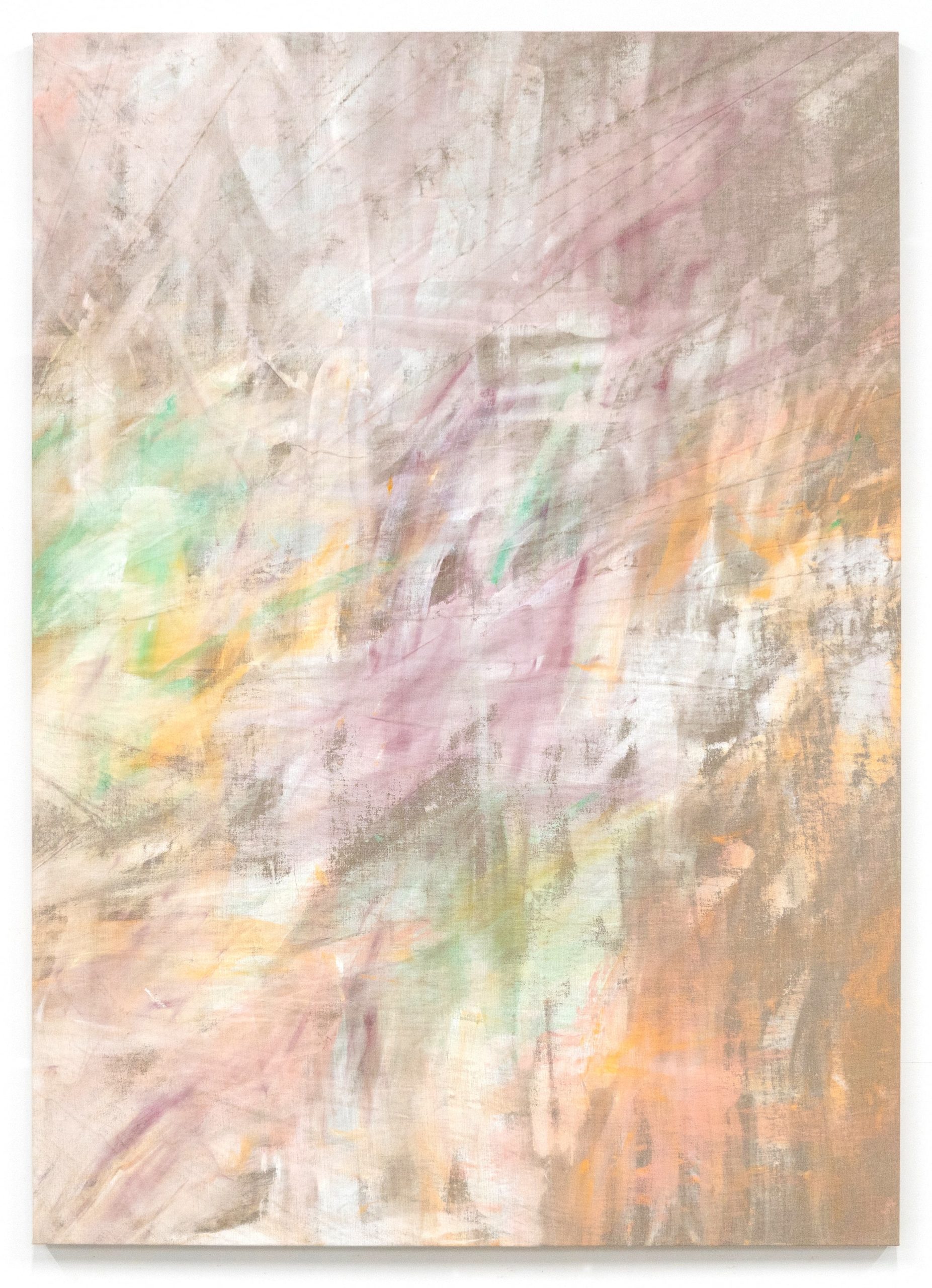 Cole Sternberg, “their tracks remained,” 2020,
Mixed media on linen,
70 x 50 inches; courtesy of the artist.
Cole Sternberg, “their tracks remained,” 2020,
Mixed media on linen,
70 x 50 inches; courtesy of the artist.







